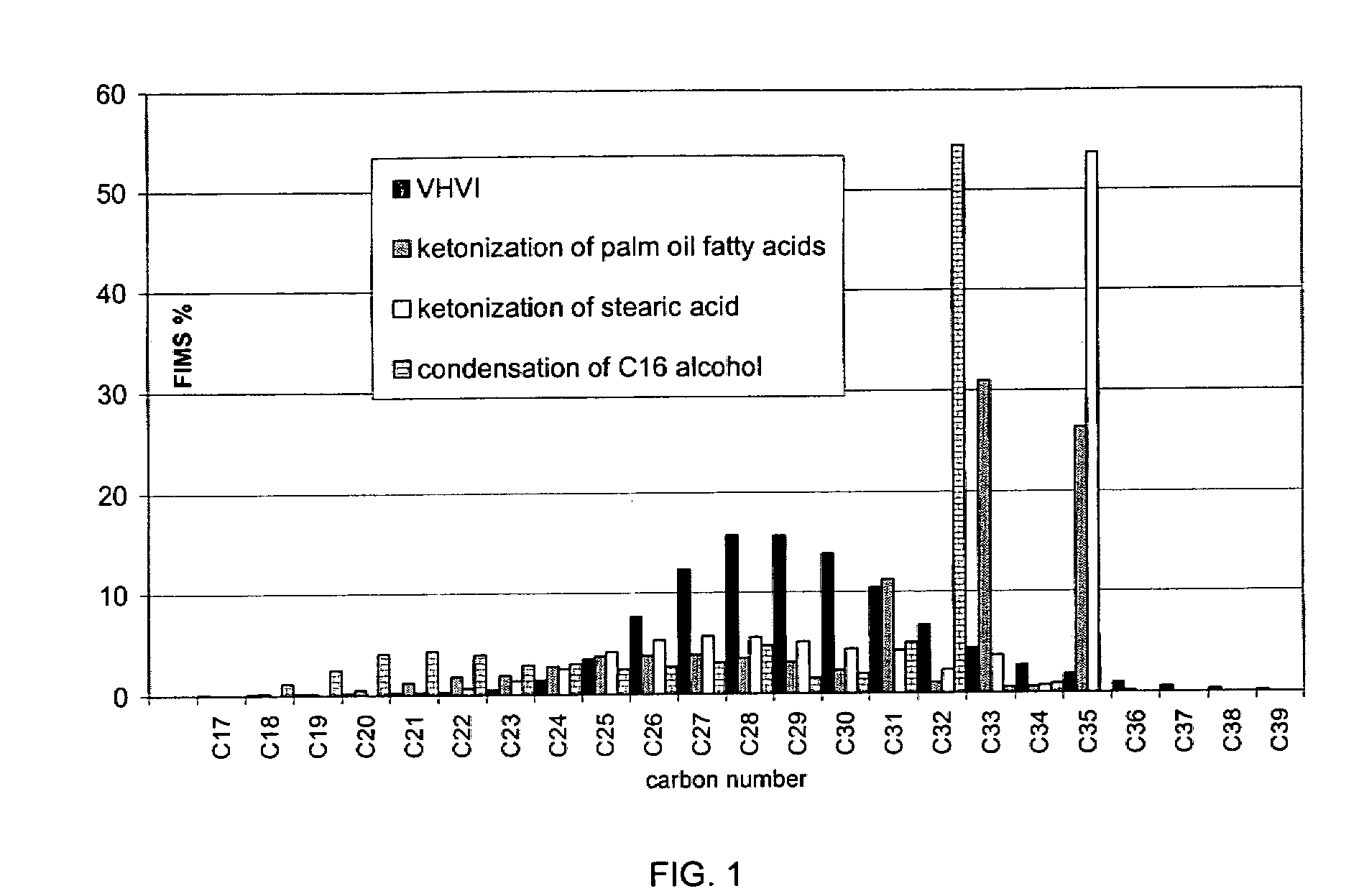Base oil
a base oil and hydrocarbon technology, applied in the direction of fuels, organic chemistry, thickeners, etc., can solve the problems of not being able to produce lubricants that meet the requirements, not being able to reduce the volatility of mineral oils, and not being able to respond modestly to antioxidant additives. , to achieve the effect of reducing the volatility of products, reducing oil consumption, and improving the quality of products
- Summary
- Abstract
- Description
- Claims
- Application Information
AI Technical Summary
Benefits of technology
Problems solved by technology
Method used
Image
Examples
example 1
Preparation of a Hydrocarbon Component from Stearic Acid Fraction
[0106] A mixture of plant oils (linenseed, soybean, sunflower, and rapeseed oils) was hydrolyzed, and the fatty acids were distilled to obtain product fractions according to carbon numbers. Double bonds of the fatty acid fraction used as the feed were selectively prehydrogenated. The stearic acid fraction (Cl17H35COOH) thus obtained was diluted with a paraffinic diesel fuel based on biological raw material. The stearic acid content of the mixture was 31% by weight. The feedstock was ketonized in a continuous tube reactor using a MnO2 catalyst. The temperature of the reactor was 370° C., and WHSV was 3. 18-pentatriacontanone, i.e, stearone, in a diluent was obtained as the product.
[0107] In the hydrogenation step, said stearone / diluent mixture obtained was hydrogenated in a high pressure Parr reactor using a dried and activated NiMo / Al2O3 catalyst to obtain linear paraffin. The ketone was hydrogenated at 330° C. under...
example 2
Preparation of a Hydrocarbon Component from Fatty Acids Derived from Palm Oil
[0109] Palm oil was hydrolyzed, and double bonds were selectively hydrogenated. After hydrogenation, the fatty acid composition was as follows: C14 1%, C16 44%, C18 54%, and C20 1%, all percentages being by weight. Fatty acids were ketonized as in Example 1, and the ketonization was followed by removal of the solvent by distillation.
[0110] In the hydrogenation step, the ketone mixture obtained above was hydrogenated in a Parr reactor using a dried and activated NiMo / Al2O3 catalyst to give a linear paraffin. The ketone mixture was hydrogenated under a pressure of 3.3 MPa, at 340° C., mixing speed being 300 rmp. Palm oil resulted in linear paraffin.
[0111] N-paraffin wax obtained from the ketone mixture, by hydrogenation, was isomerized in a Parr reactor at 340° C. under a hydrogen pressure of 3 MPa to give a branched paraffin of base oil viscosity class, using a reduced Pt molecular sieve / Al2O3 catalyst un...
example 3
Preparation of a Hydrocarbon Component from Fatty Acid Methyl Esters
[0112] Purified animal fat was transesterified in two steps with methanol under alkaline conditions at 70° C. under a pressure of 0.1 MPa, thus obtaining fatty acid methyl esters. Sodium methoxide served as the catalyst. The reaction mixture was purified by washing with acid and water. Finally, the mixture of fatty acid methyl esters was dried.
[0113] The mixture of fatty acid methyl esters was diluted with a paraffinic diesel fuel of biological origin. Fatty acid methyl ester content of the feedstock obtained was 30% by weight, and the feedstock was ketonized in a continuous tube reactor as disclosed in Example 1. Both saturated and unsaturated ketones were thus obtained as products.
[0114] In the hydrogenation step, the ketone mixture obtained above was hydrogenated in a Parr reactor as in Example 2. Also the isomerization was performed as in Example 2.
PUM
| Property | Measurement | Unit |
|---|---|---|
| Temperature | aaaaa | aaaaa |
| Temperature | aaaaa | aaaaa |
| Temperature | aaaaa | aaaaa |
Abstract
Description
Claims
Application Information
 Login to View More
Login to View More - R&D
- Intellectual Property
- Life Sciences
- Materials
- Tech Scout
- Unparalleled Data Quality
- Higher Quality Content
- 60% Fewer Hallucinations
Browse by: Latest US Patents, China's latest patents, Technical Efficacy Thesaurus, Application Domain, Technology Topic, Popular Technical Reports.
© 2025 PatSnap. All rights reserved.Legal|Privacy policy|Modern Slavery Act Transparency Statement|Sitemap|About US| Contact US: help@patsnap.com



